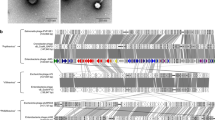Abstract
PM1, a novel virulent bacteriophage that infects Pectobacterium carotovorum subsp. carotovorum, was isolated. Its morphological features were examined by electron microscopy, which indicated that this phage belongs to the family Myoviridae. It has a 55,098-bp genome, including a 2,665-bp terminal repeat. A total of 63 open reading frames (ORFs) were predicted, but only 20 ORFs possessed homology with functional proteins. There is one tRNA coding region, and the GC-content of the genome is 44.9 %. Most ORFs in bacteriophage PM1 showed high homology to enterobacteria phage ΦEcoM-GJ1 and Erwinia phage νB EamM-Y2. Like these bacteriophages, PM1 encodes an RNA polymerase, which is a hallmark of T7-like phages. There is no integrase or repressor, suggesting that PM1 is a virulent bacteriophage.


Similar content being viewed by others
References
Altschul SF, Gish W, Miller W, Myers EW, Lipman DJ (1990) Basic local alignment search tool. J Mol Biol 215:403–410
Besemer J, Lomsadze A, Borodovsky M (2001) GeneMarkS: a self-training method for prediction of gene starts in microbial genomes. Implications for finding sequence motifs in regulatory regions. Nucleic Acids Res 29:2607–2618
Born Y, Fieseler L, Marazzi J, Lurz R, Duffy B, Loessner MJ (2011) Novel virulent and broad-host-range Erwinia amylovora bacteriophages reveal a high degree of mosaicism and a relationship to Enterobacteriaceae phages. Appl Environ Microbiol 77:5945–5954
Casjens SR, Gilcrease EB (2009) Determining DNA packaging strategy by analysis of the termini of the chromosomes in tailed-bacteriophage virions. Methods Mol Biol 502:91–111
Delcher AL, Bratke KA, Powers EC, Salzberg SL (2007) Identifying bacterial genes and endosymbiont DNA with Glimmer. Bioinformatics 23:673–679
Jamalludeen N, Kropinski AM, Johnson RP, Lingohr E, Harel J, Gyles CL (2008) Complete genomic sequence of bacteriophage phiEcoM-GJ1, a novel phage that has myovirus morphology and a podovirus-like RNA polymerase. Appl Environ Microbiol 74:516–525
Kumar S, Nei M, Dudley J, Tamura K (2008) MEGA: a biologist-centric software for evolutionary analysis of DNA and protein sequences. Brief Bioinform 9:299–306
Lee DH, Lee JH, Shin H, Ji S, Roh E, Jung K, Ryu S, Choi J, Heu S (2012) Complete genome sequence of Pectobacterium carotovorum subsp. carotovorum bacteriophage My1. J Virol 86:11410–11411
Lee JH, Shin H, Ji S, Malhotra S, Kumar M, Ryu S, Heu S (2012) Complete genome sequence of phytopathogenic Pectobacterium carotovorum subsp. carotovorum bacteriophage PP1. J Virol 86:8899–8900
Lim JA, Jee S, Lee DH, Roh E, Jung K, Oh C, Heu S (2013) Biocontrol of Pectobacterium carotovorum subsp. carotovorum Using Bacteriophage PP1. J Microbiol Biotechnol 23:1147–1153
McMahon SA, Roberts GA, Johnson KA, Cooper LP, Liu H, White JH, Carter LG, Sanghvi B, Oke M, Walkinshaw MD, Blakely GW, Naismith JH, Dryden DT (2009) Extensive DNA mimicry by the ArdA anti-restriction protein and its role in the spread of antibiotic resistance. Nucleic Acids Res 37:4887–4897
McNair K, Bailey BA, Edwards RA (2012) PHACTS, a computational approach to classifying the lifestyle of phages. Bioinformatics 28:614–618
Roh E, Park TH, Kim MI, Lee S, Ryu S, Oh CS, Rhee S, Kim DH, Park BS, Heu S (2010) Characterization of a new bacteriocin, carocin D, from Pectobacterium carotovorum subsp. carotovorum Pcc21. Appl Environ Microbiol 76:7541–7549
Schattner P, Brooks AN, Lowe TM (2005) The tRNAscan-SE, snoscan and snoGPS web servers for the detection of tRNAs and snoRNAs. Nucleic Acids Res 33:W686–W689
Summer EJ, Berry J, Tran TA, Niu L, Struck DK, Young R (2007) Rz/Rz1 lysis gene equivalents in phages of Gram-negative hosts. J Mol Biol 373:1098–1112
Wilcox SA, Toder R, Foster JW (1996) Rapid isolation of recombinant lambda phage DNA for use in fluorescence in situ hybridization. Chromosome Res 4:397–398
Acknowledgments
This work was supported by the Rural Development Administration (RDA) fund (PJ008639) and Post-Doc Fellowship to JL and DL from RDA.
Author information
Authors and Affiliations
Corresponding author
Additional information
The nucleotide sequence data reported are available in the GenBank database under the accession number KF534715.
Electronic supplementary material
Below is the link to the electronic supplementary material.
Rights and permissions
About this article
Cite this article
Lim, JA., Shin, H., Lee, D. et al. Complete genome sequence of the Pectobacterium carotovorum subsp. carotovorum virulent bacteriophage PM1. Arch Virol 159, 2185–2187 (2014). https://doi.org/10.1007/s00705-014-2005-7
Received:
Accepted:
Published:
Issue Date:
DOI: https://doi.org/10.1007/s00705-014-2005-7




